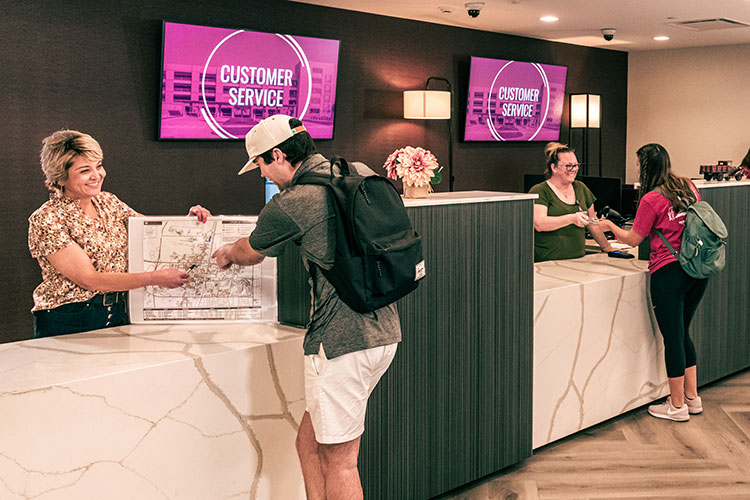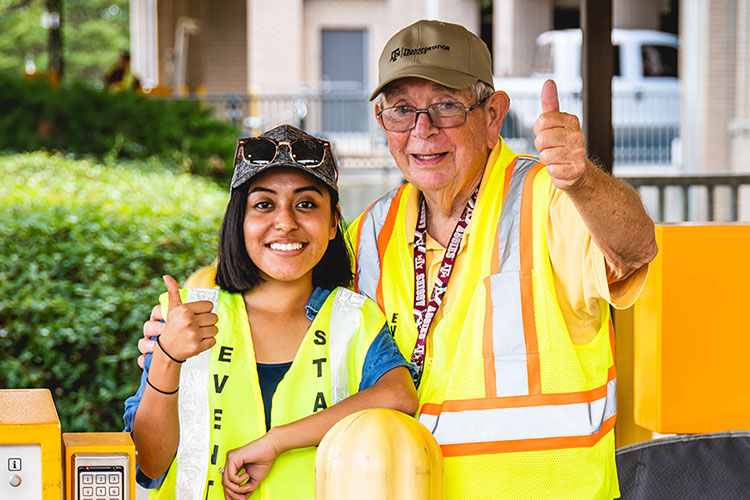Transportation Services Strategic Plan
Our Story
In March 2022, Transportation Services began a strategic planning process with a goal of defining a path for the department through the year 2027. Intentional representation from various stakeholder groups helped ensure that students, faculty, staff, departmental employees, and community partners shaped the development of the plan through a strengths-based whole system approach. The holistic process was deliberate and grounded in our guiding principles which keeps us accountable to the people we serve.

Guiding Principles
Safety
Every decision we make throughout the department maintains the safety of team members and our customers. We provide our team with the tools, time, and training they need to complete their jobs safely, creating a safe environment for our customers.
Alignment of Planning Efforts
We work closely with our campus partners to support the overall vision of Texas A&M University and our community partners to improve connections with infrastructure, services, and mobility.
Environmental Responsibility
As we continue to meet the demands of our growing community, sustainability is centered in our decisions through the physical infrastructure, accessible services, and optimal staffing to support these initiatives.
Community and Accessibility
We strive to employ team members and align services that are responsive to the communities we serve.
Steering Committee
With our principles at the core of our process, we were able to discover and celebrate the strengths of our department and the outstanding team members who bring our mission and vision to life. First, a nine-person steering committee made up of students, internal campus partners, and departmental team members, guided the development of the Strategic Planning Retreat held in April 2022.
This retreat consisted of almost 100 participants that ranged from:
- departmental staff and students
- on-campus customers: students, faculty, and staff
- off-campus partners: cities, agencies, and research partners
- vendors and contractors
Foundational Approach
Data analysis highlighted 4 priorities and 16 goals that would guide the 9 post-retreat small groups which dove deeper into the topics. These small groups ranged from 8 to 15 people with the same intentional representation from the aforementioned stakeholders. Nearly 450 comments collected from the small groups helped refine the priorities and goals then shape the strategies of the plan.
Our foundational approach is critical to our future success and shows we:
- Serve: Deliver world class service
- Communicate: Listen, inform and educate
- Engage: Work across campus and beyond to build lasting partnerships
- Innovate: Monitor the industry, embrace innovative ideas, and adapt emerging technology
Strategic Priorities
While the development of the plan is a celebratory milestone, the work is just beginning as we continue to use the data collected throughout the process to shape the implementation plan that will take place over the next several years. We are proud to showcase our plan that was created with the people that have become family in our department and the communities we have the privilege to serve.

GOAL 1: Create and maintain a culture of service, involvement, and welcome in which employees achieve their potential by being valued and striving for excellence.
Serve
Strategies:
- Value employees by paying competitive rates, offering promotional opportunities, and providing retention, wellness, work-life balance, and recruitment incentives; make Transportation Services THE place to work.
- Create formal development plans for employees and enhance career preparedness for students.
- Incentivize and reward employee excellence, dedication, and safety.
- Recruit and retain team members who are dedicated to service and teamwork and foster a harmonious work environment.
- Provide training opportunities and develop a departmental knowledge base to prepare team members to be the next leaders in the department.
GOAL 2: Embody a culture that values safety and deliberate planning, coordination, and communication.
Communicate
Strategies:
- Foster superior coordination and multi-dimensional communication among internal units to ensure our department effectively, efficiently, and safely serves the growing campus community.
- Develop and implement practices for timely coordination, planning, and communication with our partners that support safety and benefit employees through wellness and work-life balance.
- Promote dialogue throughout the department to ensure employees have input in the decision-making process.
GOAL 3: Engage employees to identify recruiting, retention, and recognition solutions.
Engage
Strategies:
- Leverage existing Texas A&M programs and explore ways to promote work-life balance, recruitment, retention, and recognition.
- Streamline our business processes to improve efficiency and accessibility of our world-class services to the campus community.
GOAL 4: Use industry best practices and technology to improve our processes and services that enhance employee efficiency, effectiveness, and well-being.
Innovate
Strategies:
- Promote innovative, efficient practices and technology to optimize effectiveness and make services more inclusive and accessible department wide.
- Leverage existing technology and explore new ways to attract, recruit and retain talented team members.
- Adopt innovative strategies and technology that make planning and operations more efficient.
GOAL 1: Leverage on-campus and community partnerships to safely serve our diverse population.
Serve
Strategies:
- Promote multi-directional communication between Transportation Services and campus service partners to better serve our campus community.
- Cultivate engaging relationships that utilize feedback to ensure practices and services are welcoming, safe, and accessible for customers.
- Foster relationships with community partners to coordinate our efforts to plan for future growth that is environmentally responsible, aligned with campus planning efforts, and coordinated with the communities.
- Optimize operations and resources through transportation demand strategies.
- Examine opportunities with campus and community partners to identify and obtain strategic funding for enhanced, leading-edge mobility initiatives and infrastructure.
GOAL 2: Engage customers to understand travel behavior, educate about options, and develop communication strategies.
Communicate
Strategies:
- Facilitate frequent student engagement to share insight and gain input to develop solutions for complex mobility challenges.
- Optimize dialogue to ensure effective and efficient two-way communication with the campus community.
- Ensure balanced representation within the Transportation Services Advisory Committee and provide members with the tools they need to enhance communication with their constituents.
GOAL 3: Collaborate with campus partners and surrounding communities to evaluate existing transportation systems and services to identify opportunities for coordinated growth.
Engage
Strategies:
- Engage partners to evaluate existing services and explore mobility options to connect our respective communities.
- Engage and enhance relationships with our partners to coordinate and plan for infrastructure growth.
GOAL 4: Utilize technological resources to improve our planning and mobility strategies.
Innovate
Strategies:
- Partner with the campus and community to develop, adopt, and promote applications, incorporating physical and technical wayfinding at decision points, so customers make informed, daily travel choices.
- Incorporate departmental and community operational and service data to ensure our services meet customer needs.
- Enhance the transportation system by improving infrastructure for safer mobility.
- Leverage campus and community partnerships to identify and develop preferred content and information delivery methods.
GOAL 1: Implement technology that helps customers and visitors have seamless campus transportation experiences.
Serve
Strategies:
- Coordinate with campus and community partners to ensure adopted technology simplifies the customer experience.
- Utilize innovative and accessible technology to incorporate feedback.
GOAL 2: Create engaging campaigns to collect feedback, raise awareness, and increase excitement about our services to meet the needs of a diverse population.
Communicate
Strategies:
- Leverage current and foster new relationships to enhance transparency and promote awareness about our services.
- Adopt targeted tools and strategies to communicate and educate customers.
GOAL 3: Use technology and evolving partnerships to promote our services and offerings.
Engage
Strategies:
- Use campus and community communication outlets to promote our services and offerings.
- Provide tools to partners to optimize planning for campus events and operations.
GOAL 4: Build our website, applications, and technology to serve the growing needs of our campus and community.
Innovate
Strategies:
- Adopt technology in conjunction with community partners so our services meet the evolving needs of our customers.
- Utilize innovative, accessible, and diverse technology to promote our services.
GOAL 1: Provide dynamic and safe mobility solutions to meet our customers’ changing needs.
Serve
Strategies:
- Offer leading edge technology promoting sustainable transportation that meets the needs of an expanding, diverse customer base.
- Identify funding for and invest in sustainable and progressive mobility solutions.
- Partner with the campus and surrounding communities to adopt and educate multimodal solutions including the “park once” philosophy.
- Engage campus and community partners to enhance connectivity with existing and new development.
GOAL 2: Dialogue with customers to identify infrastructure gaps and communicate mobility solutions.
Communicate
Strategies:
- Identify key groups and utilize multidimensional communication to identify infrastructure gaps and mobility needs, and to promote our services.
- Evaluate communication tools and messages continually to identify areas of improvement to ensure we are utilizing them comprehensively.
GOAL 3: Facilitate partnerships to expand campus and community mobility solutions.
Engage
Strategies:
- Promote and partner with the university, system agencies, and technology companies to facilitate Texas A&M as a living laboratory for transportation research.
- Collaborate with campus and community partners to apply for grants that allow us to better connect the communities through sustainable mobility solutions.
- Engage partners to identify opportunities to enhance infrastructure, business processes, and mobility options to improve services and relieve congestion.
- Partner with the campus and community to prioritize pedestrians and micro-mobility by embracing the Transportation Mode Hierarchy as outlined within the Campus Master Plan.
GOAL 4: Simplify technology and processes to enhance understanding, customer experience, use of mobility solutions, and address infrastructure gaps.
Innovate
Strategies:
- Utilize technology focused on future needs and create robust campaigns about our services.
- Embrace forward thinking business processes that adapt to the changing needs of our customers.
- Provide accessible outlets to gain feedback and identify infrastructure gaps.
Leave a Reply
Have a question or comment about the development and implementation plan? We would love to hear from you! If you prefer to anonymously respond, simply skip the name and email fields.